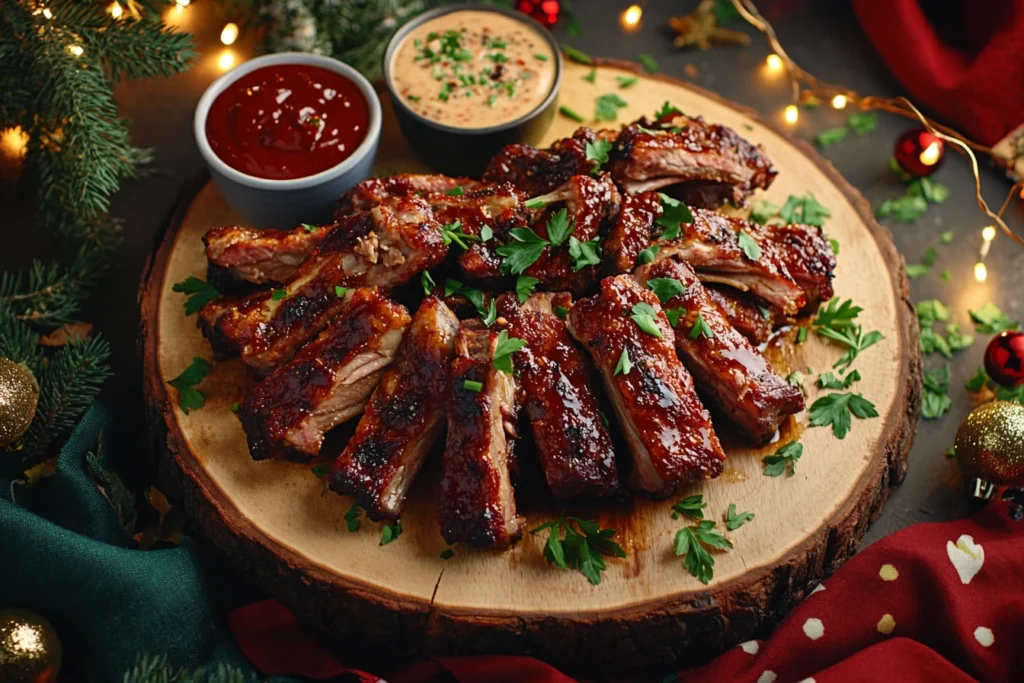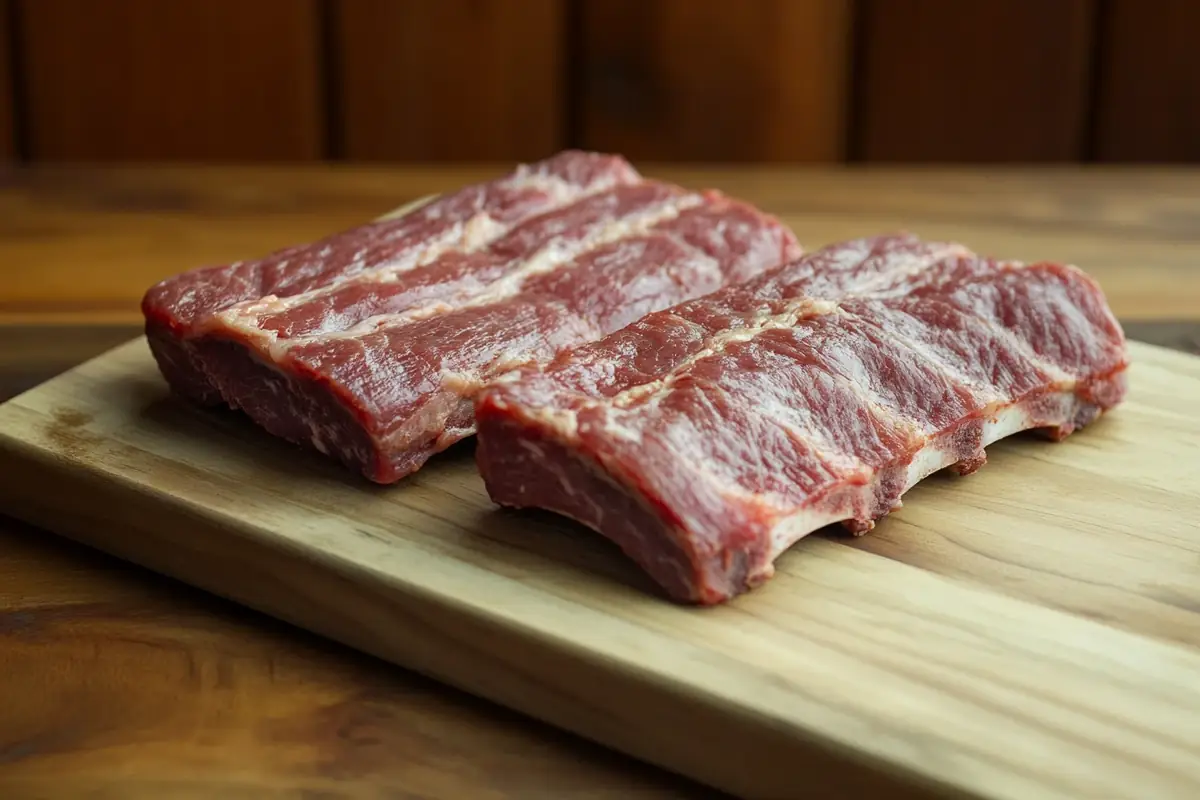What is the Difference Between Party Ribs and Regular Ribs? the ribs are a universal favorite, celebrated for their rich flavor and versatility. Whether served at backyard barbecues or cozy family dinners, they always leave an impression. But here’s the catch—there’s more to ribs than meets the eye. When someone mentions party ribs and regular ribs, the difference isn’t always obvious. This article unpacks their unique characteristics, exploring anatomy, flavor, cooking methods, and even cost considerations. You’ll learn everything from their structure to the best ways to prepare them. Let’s dive into the world of ribs, starting with the basics!
Introduction and Definitions
Understanding Rib Terminology
Ribs aren’t just ribs; they’re a spectrum of cuts, each bringing its own flavor and texture to the table. Party ribs, a term often associated with smaller, shareable cuts, contrast with the more traditional regular ribs. While the latter include staples like baby back and spare ribs, party ribs cater to gatherings with their bite-sized appeal.
Rib terminology can be a maze, with phrases like “St. Louis-style,” “rib tips,” and “country-style ribs” adding to the confusion. But worry not! The distinction lies in how these ribs are cut, their size, and their intended use.
Defining Party Ribs
Party ribs, as their name suggests, are tailored for social occasions. These ribs are typically smaller, trimmed to remove excess fat and cartilage, making them easier to handle. They’re often selected for their eye-catching presentation and quick-cooking properties, which is why they’re so popular at events.
What sets them apart is their texture—soft, tender, and perfect for finger foods. Their smaller portion size makes them easy to serve and enjoy without needing extra utensils, earning their spot as a go-to choice for gatherings.

Defining Regular Ribs
In contrast, regular ribs are the traditional cuts most people are familiar with. These include the iconic baby back ribs, known for their tenderness, and spare ribs, prized for their rich, fatty flavor. Regular ribs often come with the bone intact and are larger in size, making them ideal for hearty meals.
These ribs require more time and care when cooking due to their size and fat content. They shine in low-and-slow cooking methods like smoking or braising, which allow their deep, smoky flavors to develop.
Regular ribs may take more effort to prepare, but their satisfying chew and robust taste make them a favorite for any rib enthusiast.
Anatomical and Flavor Differences
Anatomical Differences
Understanding the anatomy of party ribs and regular ribs is key to appreciating their unique qualities. These ribs come from distinct areas of the pig, each with varying bone structures and meat distributions that directly affect their texture and cooking properties.
Party ribs are typically sourced from smaller sections of larger cuts. For instance, rib tips or sections of St. Louis-style ribs might be trimmed down into smaller, more manageable pieces to create party ribs. These smaller cuts have thinner bones or even cartilage, which makes them easier to eat but provides less meat per serving. The result? A perfect finger food that’s tender and convenient for quick bites.
On the other hand, regular ribs like baby back ribs and spare ribs come directly from larger sections of the ribcage. Baby back ribs are located higher on the ribcage, near the spine, making them shorter, leaner, and more curved. Spare ribs, found closer to the belly, are longer, flatter, and meatier, with a higher fat content. This fat contributes to their robust flavor but also requires careful cooking to render properly.
Meat distribution varies significantly between these cuts. Regular ribs generally have more meat along the bone and between the ribs, providing a heartier portion. Party ribs, however, are often trimmed down to focus on presentation and ease of consumption, with less overall meat but more tender textures.
Flavor Profiles
The taste differences between party ribs and regular ribs lie in their fat content and marbling. Party ribs tend to have a leaner profile, especially if trimmed from less fatty parts of the rib section. This leanness gives them a lighter flavor, which pairs well with sweet or tangy marinades and glazes. However, they may lack the deep richness that comes from the fat melting during cooking.
Regular ribs are the flavor powerhouses of the rib world. Spare ribs, in particular, boast generous marbling and fat layers that baste the meat as it cooks. Baby back ribs, while leaner, still retain enough fat to deliver a juicy and satisfying bite. Smoking or slow-cooking these ribs intensifies their natural flavors, creating that melt-in-your-mouth sensation.
Cooking techniques also influence flavor. Party ribs excel with quick, high-heat methods like grilling, which locks in moisture and caramelizes the surface. Regular ribs, on the other hand, thrive in low-and-slow methods that break down tough fibers and allow the fat to render fully, producing a smoky, tender masterpiece.
Each rib type brings something special to the table, catering to different taste preferences and occasions. So whether you’re seeking the convenience of party ribs or the bold flavor of regular ribs, understanding these nuances ensures the perfect choice every time.
Cooking Methods and Nutritional Information
Best Cooking Methods for Party Ribs and Regular Ribs
Cooking party ribs and regular ribs requires different approaches to bring out their best flavors and textures. Each type of rib responds uniquely to various techniques, so understanding the right method for each ensures mouthwatering results.
Grilling Party Ribs and Regular Ribs
Grilling is a fast and effective method for cooking both party ribs and regular ribs. Party ribs, being smaller and leaner, cook quickly on medium-high heat (around 350°F) and are ideal for achieving a caramelized glaze. Regular ribs, such as baby back ribs, can also be grilled but require indirect heat and a longer cooking time to prevent drying out. Adding marinades or basting sauces enhances the flavor for both types.
Smoking Party Ribs vs. Regular Ribs
Smoking is the gold standard for regular ribs, especially spare ribs, which have higher fat content. Low-and-slow smoking at 225°F for several hours allows the fat to render and infuses the meat with deep smoky flavor. Party ribs can also be smoked, though they typically require less time due to their smaller size. This method is perfect for creating tender, flavorful ribs that fall off the bone.
Braising Party Ribs and Regular Ribs
Braising involves cooking ribs in a flavorful liquid at a low temperature, making it an excellent option for both party ribs and regular ribs. For party ribs, a shorter braising time ensures they remain tender without overcooking. Regular ribs, with their tougher texture, benefit from longer braising, which softens the meat and enhances richness.
Cooking Times and Temperatures for Party Ribs and Regular Ribs
The ideal cooking times and temperatures differ significantly between party ribs and regular ribs.
Cooking Party Ribs Quickly and Efficiently
Party ribs are best cooked using high-heat methods like grilling or roasting. At 350°F, they can be ready in just 15–20 minutes, making them perfect for last-minute gatherings. Flipping them frequently prevents burning and ensures even cooking.
Cooking Regular Ribs Low and Slow
For regular ribs, patience is key. Smoking spare ribs at 225°F for 4–6 hours creates a melt-in-your-mouth texture. Baby back ribs cook slightly faster, requiring about 3–4 hours at the same temperature. When using an oven, wrapping regular ribs in foil and baking them at 300°F for 2–3 hours achieves tender, flavorful results.
Key Temperature Guidelines for Both Ribs
For safety and optimal tenderness, party ribs should reach an internal temperature of 165°F, while regular ribs benefit from being cooked to 190–205°F. This range ensures that the connective tissues break down, making the ribs juicy and tender.
Nutritional Differences Between Party Ribs and Regular Ribs
The nutritional profiles of party ribs and regular ribs vary, which may influence your choice depending on dietary preferences.
Are Party Ribs Healthier Than Regular Ribs?
Party ribs are often leaner, containing fewer calories and less fat than regular ribs. A serving of party ribs typically provides 250–300 calories and 15–20 grams of protein, making them a lighter option for those watching their calorie intake.
How Regular Ribs Compare in Nutrition
Regular ribs, especially spare ribs, are higher in fat due to their marbling. A serving of spare ribs can range from 350–450 calories, with 20–25 grams of protein. Baby back ribs are slightly leaner but still richer than party ribs.
Tips for Healthier Ribs
To make either type of rib healthier, trim visible fat before cooking and avoid sugary glazes. Opt for spice rubs or low-sugar marinades to enhance flavor without adding excess calories. Serving ribs alongside nutrient-rich sides like steamed vegetables or whole grains can balance out their richness.
Cost, Recipes, and Pairings
Cost Considerations
The price difference between party ribs and regular ribs is often dictated by their cut, demand, and availability. Party ribs, being smaller and more refined, are typically priced slightly higher per pound compared to regular ribs. Their appeal as a specialty item for gatherings drives their market value, especially during festive seasons.
Regular ribs, particularly spare ribs, tend to be more affordable. They are larger and less processed, making them a budget-friendly choice for feeding a crowd. Baby back ribs, being leaner and more tender, are often the most expensive among regular ribs. Seasonality also plays a role; prices may spike during barbecue season due to increased demand.
In terms of availability, regular ribs are more commonly found in grocery stores and butcher shops, whereas party ribs might require special ordering or pre-trimming. Despite their cost differences, both types offer excellent value depending on the occasion and preparation method.
Popular Recipes for Party Ribs
Party ribs shine when prepared with bold flavors and quick-cooking techniques. Here are some must-try recipes:
Grilled Party Ribs with Honey Glaze
Start by marinating the ribs in a mixture of honey, soy sauce, garlic, and ginger for at least two hours. Grill them over medium heat for 15–20 minutes, turning frequently. Brush on additional glaze during the last few minutes for a caramelized finish.
Smoked Party Ribs with Dry Rub
For smoky perfection, coat party ribs with a dry rub made from paprika, brown sugar, chili powder, and garlic powder. Smoke them at 225°F for about 1.5 hours. Serve with a tangy dipping sauce for a flavorful punch.
Sweet and Spicy Sticky Ribs
Bake party ribs at 350°F for 25 minutes, then coat them with a sauce made from hoisin, sriracha, and a touch of lime juice. Broil for an additional 5 minutes to create a sticky, irresistible glaze.
Popular Recipes for Regular Ribs
Regular ribs benefit from slow cooking methods that break down their tougher fibers and enhance flavor:
Oven-Baked Baby Back Ribs
Rub the ribs with a mixture of salt, pepper, garlic powder, and smoked paprika. Wrap them tightly in foil and bake at 300°F for 2.5 hours. Finish with your favorite barbecue sauce under the broiler for a caramelized crust.
Barbecued Spare Ribs
Smoke spare ribs at 225°F for 4–5 hours, basting occasionally with a vinegar-based barbecue sauce. This slow-smoking method creates tender ribs with a deep, smoky flavor.
Slow Cooker Ribs
Place ribs in a slow cooker with sliced onions, garlic, and a mix of apple cider and barbecue sauce. Cook on low for 6–8 hours. Finish on the grill or under the broiler for a crispy exterior.
Pairing Suggestions
The right sides and accompaniments can elevate the rib experience. For party ribs, light and zesty options like coleslaw or a fresh cucumber salad provide balance. Cornbread muffins and roasted sweet potatoes are also excellent complements.
For regular ribs, hearty sides like baked beans, mac and cheese, or grilled corn on the cob work wonders. Mashed potatoes or garlic bread can also round out the meal.
As for beverages, choose refreshing options like iced tea, lemonade, or sparkling water infused with citrus. Their crispness cuts through the richness of the ribs, enhancing the overall dining experience.
Regional Preferences, Health, and FAQs
Regional Preferences
The way ribs are prepared and enjoyed varies across the globe, reflecting the culinary traditions and flavors of different regions. In North America, Kansas City-style ribs are a hallmark of barbecue culture. These ribs, typically spare ribs, are coated in a thick, sweet tomato-based barbecue sauce and slow-cooked until tender. Memphis-style ribs, on the other hand, rely on dry rubs that blend paprika, garlic, and other spices for a bold and smoky flavor.
Across the Atlantic, Korean-style short ribs (galbi) offer a completely different take. These ribs, often thinly sliced across the bone, are marinated in a sweet and savory blend of soy sauce, sugar, garlic, and sesame oil. They are then grilled quickly over high heat, resulting in a caramelized exterior and juicy interior.
In South America, asado-style ribs are popular, often grilled over an open flame and seasoned simply with salt. Meanwhile, in the Caribbean, jerk-spiced ribs feature a fiery mix of allspice, Scotch bonnet peppers, and thyme, showcasing the region’s love for bold flavors.
Regional preferences highlight the versatility of ribs and the endless possibilities for flavor and preparation.
Health Considerations
When it comes to health, ribs can be both indulgent and adaptable. Party ribs are often leaner, making them a slightly healthier option for those watching their fat intake. Regular ribs, particularly spare ribs, have a higher fat content, contributing to their rich flavor but also raising concerns about calorie and cholesterol levels.
For a healthier approach, consider trimming excess fat before cooking. Opt for marinades and rubs with minimal added sugars and salt to reduce calorie and sodium intake. Grilling or smoking ribs allows fat to drip away during cooking, making them a better choice compared to frying.
Pairing ribs with nutrient-dense sides like steamed vegetables, quinoa, or a fresh salad can also balance the meal. For portion control, serving smaller amounts of ribs alongside hearty sides ensures satisfaction without overindulgence.
Frequently Asked Questions (FAQs)
What are the main differences between party ribs and regular ribs?
The primary differences lie in size, preparation, and use. Party ribs are smaller, more refined cuts meant for easy handling and social settings. Regular ribs, like baby back and spare ribs, are larger and more traditional, ideal for hearty meals.
Which type of rib is more tender?
Tenderness often depends on the cut and cooking method. Baby back ribs are naturally tender due to their location near the spine, while properly cooked party ribs can be equally soft. Spare ribs, with their higher fat content, become tender with low-and-slow cooking.
How do cooking methods affect the taste of each rib type?
Quick cooking methods like grilling bring out the light, smoky flavors of party ribs, while slow-cooking techniques like smoking or braising enhance the richness of regular ribs by breaking down connective tissues and infusing deep flavors.
Are there significant nutritional differences between the two?
Yes. Party ribs are generally leaner, with fewer calories and less fat. Regular ribs, especially spare ribs, contain more fat and calories but offer a richer flavor. Baby back ribs are slightly leaner than spare ribs, falling between the two.
Which type is more cost-effective?
Regular ribs, particularly spare ribs, are more cost-effective due to their larger size and greater meat yield. Party ribs, being smaller and often pre-trimmed, can be pricier per pound.
What are some popular recipes for each type of rib?
For party ribs, recipes like grilled honey-glazed ribs or sticky sweet-and-spicy ribs are crowd-pleasers. Regular ribs shine in recipes such as oven-baked baby back ribs or smoked spare ribs, where slow cooking allows their flavor to fully develop.
Conclusion For Anatomical And Flavor Differences Between Party Ribs and Regular Ribs
In the world of ribs, the choice between party ribs and regular ribs boils down to personal preference and occasion. Party ribs are the ultimate crowd-pleasers, offering convenience, tenderness, and an easy-to-eat format that’s perfect for gatherings. Their quick cooking time and versatility in flavor pairings make them a favorite for casual settings and events.
Regular ribs, on the other hand, bring a bold, hearty experience to the table. Whether it’s the tenderness of baby back ribs or the rich, smoky flavor of spare ribs, they’re ideal for slow-cooked meals that showcase depth and complexity. From grilling to smoking, regular ribs deliver robust flavors that satisfy even the most discerning barbecue enthusiasts.
Both types offer unique qualities that cater to different tastes and occasions. Why not explore both? Trying each will expand your culinary horizons, helping you appreciate the nuances that make ribs a beloved delicacy worldwide.

